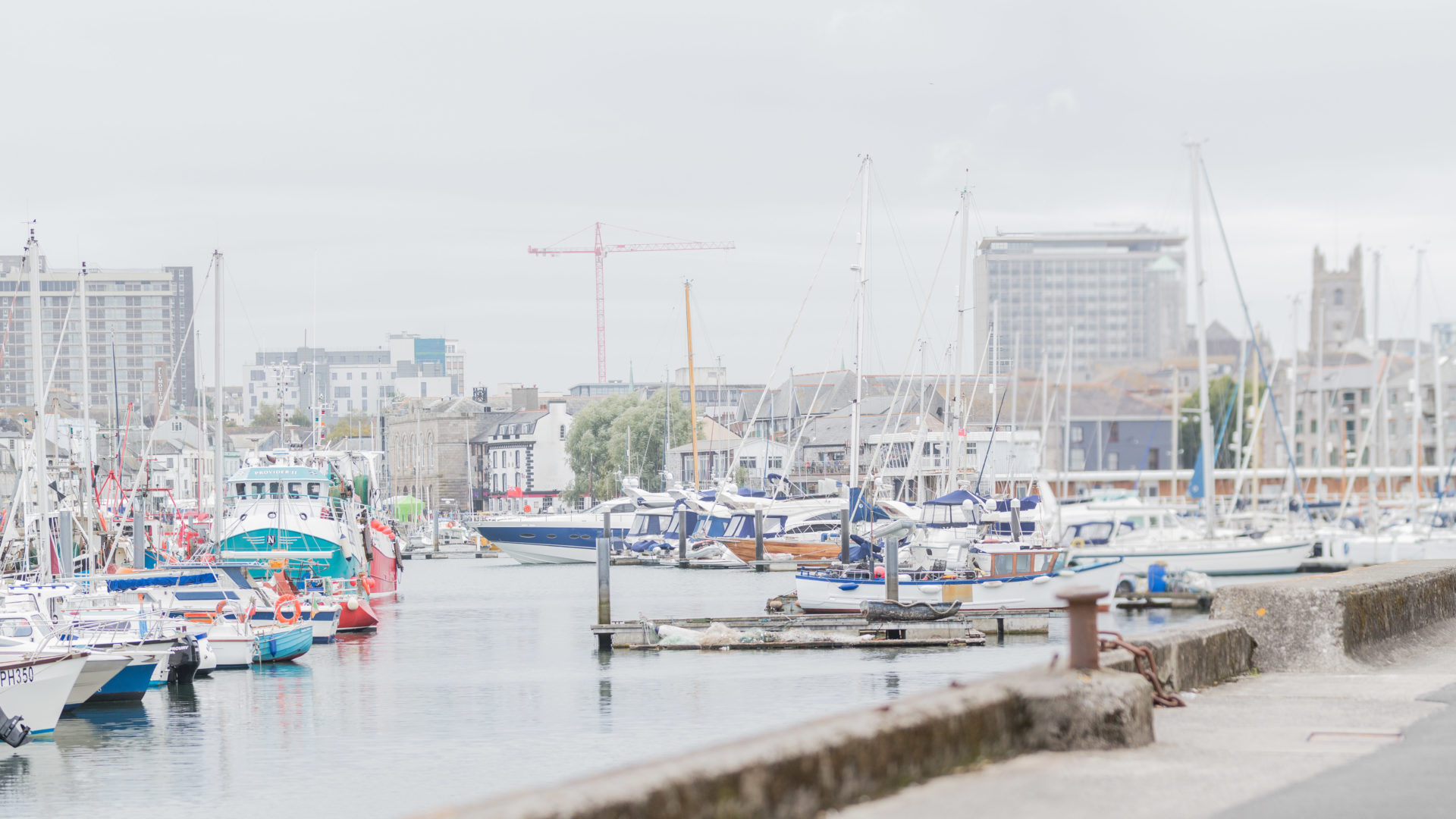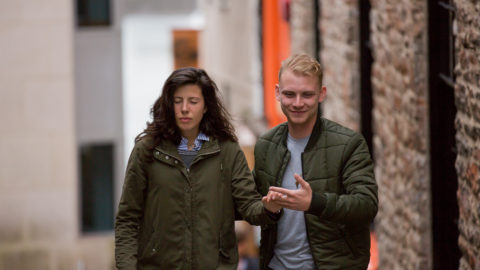For Plymouth Art Weekender we invited artist Myriam Lefkowitz to bring her ongoing exploration of the city, Walk, hands, Eyes (a City) to Plymouth. On 23 / 24 / 25 September Myriam brought together performers from Paris and Plymouth together for the first time to guide people from the ordinary to the extraordinary.
Ahead of the performance we spoke to Myriam about her practice and what it is like to get lost in cities around the world.
You have been developing and performing Walk, hands, Eyes (a City) for a few years, how and why did you begin this exploration?
There was no clear why at the time. The start of the practice was somehow accidental. I wanted to show a place to a friend of mine, a big industrial space which had a super strong atmosphere and affected me quite a bit when I discovered it, and I wanted to make it a surprise so as we were standing in front of the door, I just said: “close your eyes”. I had to guide her in the space through touch since she couldn’t see anymore. We had been dancing together for quite a long time so we had an instant physical connection that made it interesting to walk in this way in the space. There was suddenly a lot going on as our two bodies connected and moved in space tuned to each other. It was a small dance and when we ended it, she was crying. Then I realized I had discovered something special to explore.
So, I started to invite friends to meet me at the same metro stop and take them to the same industrial space. I did this for a few months to understand what I was doing and what was happening. After a while a friend invited me to do it at a festival in Sweden so the city entered the situation. It seemed that I had built up a score to move through space in this industrial space that I could play with in any situation. I didn’t need to know where I was. I just needed to know how I was walking with someone.
The few months of repetition in the industrial space was a way for me to understand the tools at use in the experience. Basically on how could I compose a walk made of touch, volumes of space, images relying on the available contrasts that my environment provides. What was really amazing was to see how strong our capacity to create other spaces, others worlds. The reality that we show as guides is like a trampoline: the thing you need to bounce on to be able to fly a little and get a different perspective on the world.
“I wonder how and what we will dream of in Plymouth”
By removing one of the senses Walk, hands, eyes forces the viewer to change the way they experience the built environment. What, if anything, do you hope participants will take away from taking part in the performance?
My hope is that we enter in some sort of speculative machine. The walk should have the capacity to let us experience a reality that contains the possibility of a transformation. A reality that doesn’t have this fixed and taken for granted shape that we need to deal with when we are busy with all the things we have to do. Is there a way to experience our existing environment without any functional dimension?
I’m very interested in the relation between this sensory augmentation and imaginary activity. I’m trying to create the conditions for us to acknowledge new worlds. Since we have nothing else to do during this walk, we have the time and the space to encounter them, understand them, share them.
I think that we need to experience new forms of sensoriality for our imaginary activity to be re activated, especially in those strange times…
You have been artist in residence at La Piscine, Paris, for some time now. Can you tell us about this and how it has affected your practice?
La Piscine is a collective project which proposes to share a set of different sensorial and conversational practices in a public space in use.
The practices are brought from different artists (we learn them from one another and are able to activate all of them in La Piscine) that share similar concerns for relation, for co-constructed experience more than for performance, for the sensorial body, for creating practices that question our usual mode of attention.
Our idea was to propose sessions to visitors in a public space which was in use so that the environment where we would share those practices would be located in an inhabited world. Not in a art institution but in an environment which already had users, habits, dynamics.Our task was to tune to what was already present and not consider it as a backdrop but include it inside the experience of La Piscine. Nothing was out of what was “happening”.
The first edition happened in a public swimming pool which carries a strong history of public care in a “red suburb” of Paris, an area with a important working class social History. We wanted to see what kind of dialogue could emerge between our practices and this particular location. Considering the collapse of welfare state at the moment, we somehow wanted to imagine and share other forms of “public service”.
We stayed in this swimming pool for 6 months. The idea was to move away from the performance time format. Do something that you can repeat, something that is available, that inhabits a public space without being an event but by being there on a regular time basis. Our desire was to be able to engage a wider audience than the one that is already interested in art. The fact of displacing the practice out from the art institution could be one of the solutions to address what we do to the ones that would not put a foot in an art centre. I would love to move from one swimming pool to a library to a gymnasium to a school and settle for a while disseminate the practice and leave.
Having performed the project in many cities around the world have you found similarities in how people react or how the work is perceived? Or is it always a completely unique, unexpected experience?
Both. The walk is at the same time a machine that tells you that anywhere in the world we can alter our senses, we can relate to vision and touch in a different way that what we are used to, we can imagine through our senses etc.There is something quite generic about this experience in the sense that it doesn’t need any specific context or specific people to do it. But at the same time, each person and each city has very specific qualities that the walk will discover as it goes on encountering people and places. It is only about variations. About all those little differences that produce a very specific moment each time you meet someone and a place.
The walk is a machine that asks you to listen to whatever is there in the moment. This is what the task is basically. Relying on that task, you start noticing so many differences: how people in certain places relate to touch for example. In some cultures it is very common in some others it is already a big deal. How differently the people react to the walk in different areas is also quite strong. The degree of empathy, of interaction with the situation if you’re in Medelin or in Stockholm is quite different. How people let themselves be seen is also very specific corresponding to where you are. How it is possible to enter places or not, so all the issues of private and public space is also in question in the walk. It is like dreaming in a way. I don’t think we dream with the same ingredient in Venice that we do in or Geneva or Buenos Aires. I wonder how and what we will dream of in Plymouth.
With each iteration of the project, new performers are trained to help deliver the project.. What do you hope they will achieve or experience from being involved and how does it impact upon the project itself?
I’m interested in sharing the work with local artists to see how the practice might be able to disseminate in other hands, other eyes, other bodies, other minds. I was curious of how other people would use this “device”. What would it do to them and to the walk? What would they “see” by practicing it? I guess it only became a practice through the transmission to other artists. I had to understand what was at stake in the walk to be able to pass it on. This is one of the most interesting aspects of the practice now actually, to continue to try to understand it as it moves on to other guides.
Somehow the local artists that we meet each time guide us in the city that they already know and we guide them in the practice that we’ve been developing for years now. This exchange allows us to be introduced in a context by the ones who experience it on a daily basis and allow them to enter in their daily environment with a different filter. The idea is to use this particular practice for the relational tool that it is and see where it takes us.



